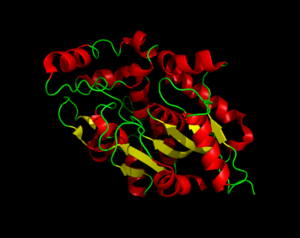Sandbox reserved 914
From Proteopedia
(Difference between revisions)
| (4 intermediate revisions not shown.) | |||
| Line 7: | Line 7: | ||
== Structure == | == Structure == | ||
| - | The secondary structure of PPT1 contains several α-helices and few β-sheets. | + | The secondary structure of PPT1 contains several α-helices and few β-sheets. |
| + | |||
=== α/β Hydrolase Fold === | === α/β Hydrolase Fold === | ||
| - | The α/β Hydrolase Fold is common to many other hydrolases. This fold consists of β3-β8, αA, αB, αC, and αF. | + | The α/β Hydrolase Fold is common to many other hydrolases. This fold consists of β3-β8, αA, αB, αC, and αF. The α/β hydrolase fold has a central 6 stranded parallel Beta sheet. There is also a helix that is roughly perpendicular to the direction of the beta sheet. There is also a large insertion, containing 6 helices, that forms a second domain that encompasses most of the fatty acid binding site. |
=== Catalytic Triad === | === Catalytic Triad === | ||
| - | + | The catalytic triad is composed of Ser115, His289, and Asp233, which is the same as the catalytic triad in chymotrypsin. | |
| + | A water molecule is occupying the oxyanion hole and it is hydrogen bonded to ser115. | ||
| + | |||
===Hydrophobic Groove === | ===Hydrophobic Groove === | ||
| + | |||
| + | The hydrophobic binding groove is located in the second domain of PPT1, where palmitate mainly binds. The fact that palmitate has to bend to fit into the binding pocket suggests that this pocket is designed to bind an unsaturated fatty acid. | ||
== Function == | == Function == | ||
| + | |||
===Biological === | ===Biological === | ||
| - | PPT1 is biologically involved in sensory transduction and the vision process. | + | PPT1 is biologically involved in sensory transduction and the vision process. |
| + | |||
===Molecular === | ===Molecular === | ||
The main molecular function of PPT1 is to breakdown lipid-modified proteins. | The main molecular function of PPT1 is to breakdown lipid-modified proteins. | ||
| - | + | ||
| + | ==Medical Relevance== | ||
| + | PPT1 mutations are the root cause of several diseases, specifically those where mutations cause a decrease or depletion of PPT1. Infantile neuronal ceroid lipofuscinosis (INCF) is characterized by impaired mental and motor development, including difficulty with walking, speaking, and intellectual function, beginning around the first or second year of life. The PPT1 mutation involved in INCF replaces an arginine with a stop signal in the instructions to make the enzyme. This mutation leads to a vast reduction in the production of PPT1, which impairs the removal of fatty acids from proteins. This impaired removal leads to fatty acid accumulations throughout the body, particularly in neuronal cells in the brain. Late-infantile neuronal ceroid lipofuscinosis has the same characteristics as INCF, but the mutation varies slightly. This leads to a slight reduction in the activity of PPT1 instead of completely wiping it out. | ||
| + | Mutations can also cause premature stop signals to be added to the instructions to create PPT1, resulting in Kufs disease. This is characterized by seizures, problems with movement, and a decline of intellectual function, usually beginning in early adulthood. Although premature stop signals are added, these mutations allow enough PPT1 to be produced so that the onset is later on in life and the life expectancy is higher. | ||
| + | |||
| - | == Headline text == | ||
| - | == | + | == External Resources == |
</StructureSection> | </StructureSection> | ||
Current revision
Palmitoyl-Protein Thioesterase 1
| |||||||||||

